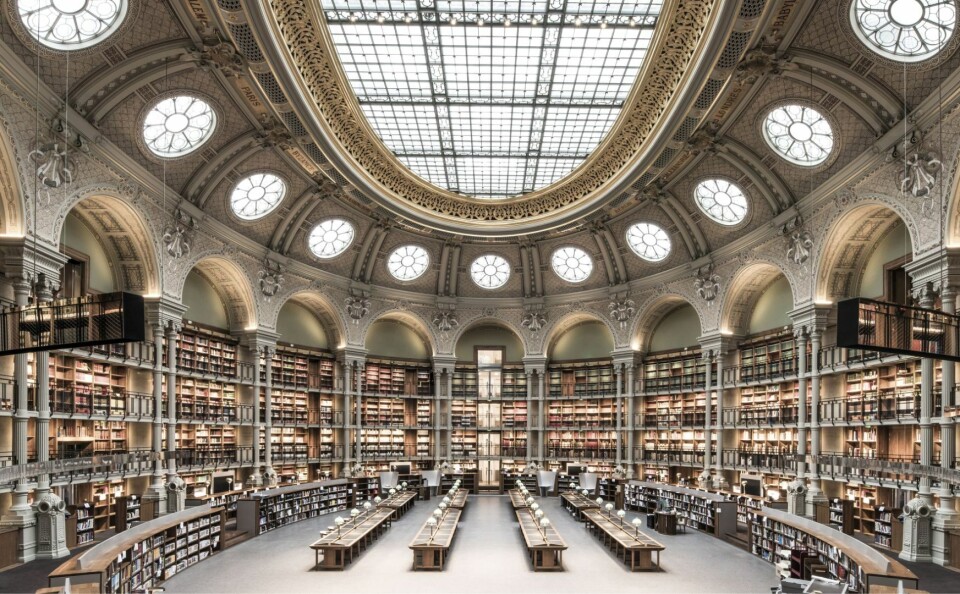-
Fines for driving in central Paris delayed until September
‘Educational period’ to be extended with drivers only cautioned for breaking rules
-
Paris pledges action against voyeurs in public swimming pool changing rooms
It comes after several women came forward to report similar sexual assaults
-
What is known about large fire at recycling centre in Paris
Residents nearby are being urged to remain cautious over inhaling smoke
France’s stunning national library is a reader's paradise open to all
We discover the newly renovated Bibliothèque Nationale de France in Paris, home to rare books and treasures

The Bibliothèque Nationale de France (BnF) contains copies of everything ever published in France.
It is located in two sites in Paris, the François Mitterrand building and the Richelieu building, which was re-opened last year after renovation and restoration works lasting nearly a decade.
The magnificent Oval reading room, with its beautiful wooden panelling and massive oval skylight, contains around 20,000 books, graphic novels and other media.
Nicknamed the ‘Oval Paradise’ it is open to the public every day, free of charge.
Anyone can go and read the books, study at one of the desks or simply appreciate the fabulous architecture.
Read more: Joining a library in France: A free way to improve your French
Holds a copy of rare Gutenberg Bible
One of the rarest books contained in the collection is a copy of the Gutenberg Bible, which was the earliest major book printed using mass-produced movable metal type in Europe.
It marked the birth of printed books in the West. Only forty-nine copies ever survived, and they are estimated to be amongst the world’s most valuable books.
Children’s activities
Children are also encouraged to visit, and there are special activities for them on Wednesdays, Saturdays, Sundays and during the school holidays.
Get tickets online because places disappear fast.
Workshops include activities such as making a paper globe (for children aged four years and over) or writing a message using hieroglyphs on a papyrus scroll (for six years old and over).
Read more: Six things that show the French love for books and reading
Museum displays original manuscript of Les Misérables
The building also houses a stunning 1,200 m2 museum displaying around 900 artefacts from antiquity to the present day including the Great Cameo of France, the Throne of Dagobert and Charlemagne’s chess set.
Tear your eyes away and look up to admire the wonderful ceiling.
As well as documents like Victor Hugo’s original manuscript of Les Misérables, there are prints by Rembrandt and Picasso, photographs, costumes and other objects.
As well as the permanent display, there will be temporary exhibitions.
Garden and guided tours
A new digital installation offers a wealth of immersive experiences, digitally trying on some of the costumes displayed in the museum for example.
For those who prefer the outdoors, the Jardin Vivienne is open to the public.
For researchers with a valid Pass Recherche, there are specialised collections; performance arts, maps and charts, engravings and photographs, manuscripts, coins, medals and antiques, and music.
It is possible to take a guided tour of the whole beautiful building, as well as the exhibitions, museum and reading room, or sign up for a workshop (they also have them for adults).
The Rose Bakery is open to the public from Tuesday to Sunday (10.00 to 18.00) selling sweet and savoury snacks using fresh produce. There is also a bookshop.
Remained open throughout the Revolution
Designed at the end of the 19th century by Jean-Louis Pascal and inaugurated in 1936, the library is now designed to be open to everyone, and to make culture and literature available to anyone.
The collections were founded by the medieval kings of France and have developed throughout the ages. They are still growing as more books are added almost daily.
The reason the site is named after Richelieu is because the BnF was first installed in the former Mazarin Palace in 1722.
The palace eventually became part of the Richelieu site of the BnF.
The library, due to a massive programme of acquisitions, became the largest collection of manuscripts and rare books in Europe.
During the Revolution it remained a working library open to the public, and due to confiscations of valuable books during the revolution, the collections grew exponentially.
Many works of art were also added. The historical science collections are still growing thanks to large donations.
Related articles
Paris looks for new ‘bouquinistes’ to run book cabins next to Seine
Le Petit Prince manuscript travels from US to France for first time
Parisian photographer shows a much darker side of the City of Light
























